How To Find and Fix Nutrient Deficiencies and Toxicities in Cannabis Plants
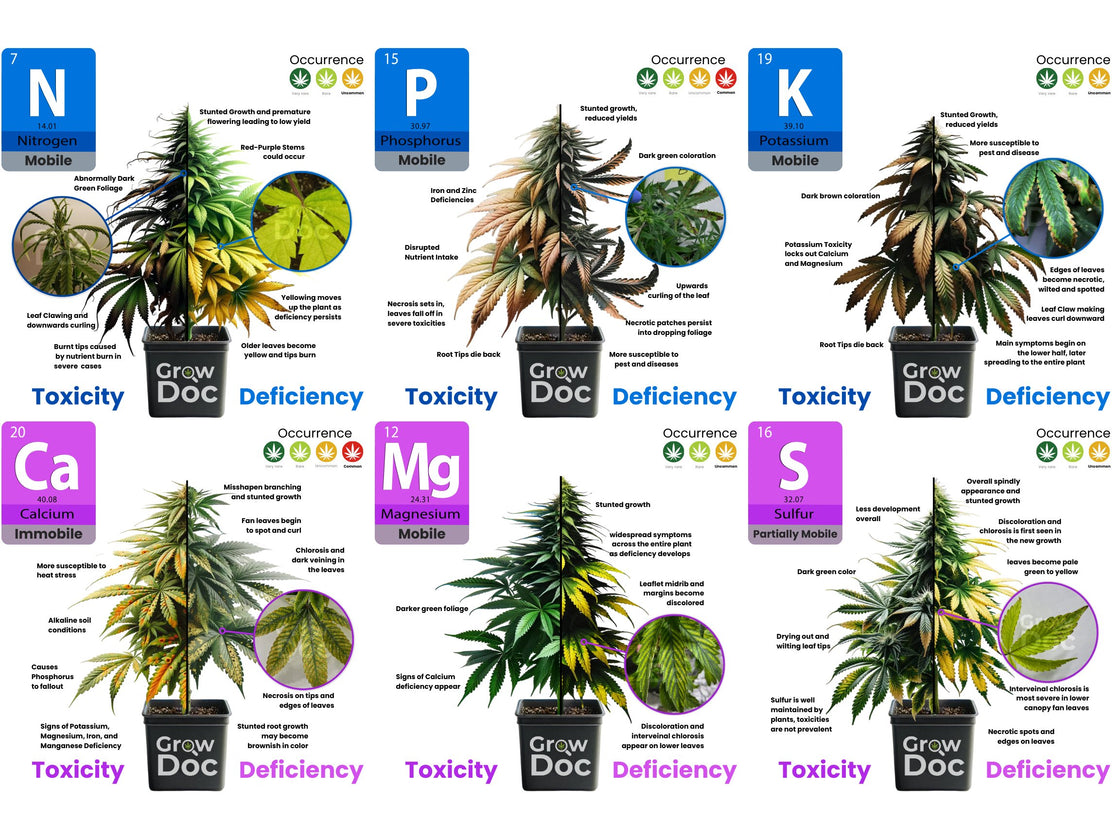
Concerned about the health of your cannabis plants? You're not alone. Understanding nutrient management is key to keeping your plants thriving. This guide focuses on essential nutrients, covering more than just nitrogen, phosphorus, and potassium, but also the vital roles of calcium, magnesium, and sulfur. It's tailored for growers in any setup soil, hydroponics, or coco coir offering solutions for both deficiencies and toxicities. With this article, you'll have the knowledge to address your plants' needs effectively, ensuring they stay healthy and productive.
Drawing on the collective expertise of Grow Doc's alliance with leading research entities—Colorado State University Pueblo, CCNB Innov, and Niagara College—this guide synthesizes advanced research with Future Harvest's practical cultivation know-how. Our collaboration ensures the information presented is grounded in the latest scientific findings, positioning you at the cutting edge of nutrient management in cannabis cultivation.
Key Principles of Nutrient Management
Managing nutrients in cannabis cultivation is much more than just simple fertilization; it's a delicate balancing act that blends scientific know-how with the finesse of gardening. It's all about understanding your plants' nutritional needs as they grow and change. Getting this right is crucial not just for avoiding common growing pains but for ensuring your plants are healthy and yield the best they possibly can.
-
Optimal Concentrations: Getting the amount of nutrients just right is a bit like cooking; too much or too little can spoil the whole recipe. For plants, this balance is crucial. Overdoing it can lead to nutrient burn, while not enough can leave plants starved and struggling.
-
Correct Ratios: Think of nutrients like a team, where each player has a role. The balance between them is what keeps the team winning. If one nutrient overshadows the others, it can throw off the whole game, affecting how well plants absorb and use these vital resources.
-
pH Regulation: The pH level is like a gatekeeper. It decides what nutrients get absorbed and how well. Keeping this gatekeeper happy, meaning within the optimal pH range, is crucial for making sure your plants get what they need from the soil or solution.
-
Monitoring and Adjustment: This is all about staying tuned in to your plants’ needs. Regular testing lets you know what your plants are getting and what they’re missing. Adjusting based on these tests, along with observing your plants' health, keeps everything in check and your plants thriving.
- Distinct Considerations for Different Grow Media:
- Soil Cultivation: In soil, nutrient dynamics are influenced by organic matter, texture, and microbial activity. Nutrients are more slowly available and require careful balancing.
- Hydroponics: In hydroponic systems, nutrients are delivered directly in water, requiring precise solution management. The absence of soil means a higher level of control over nutrient composition.
- Coco Coir Cultivation: Coco coir, a peat moss alternative, has unique water and nutrient retention properties. It requires careful calibration of nutrient concentrations and pH, as it can hold onto certain elements, altering their availability to the plant.
Cannabis Deficiency Chart

Notice: To enhance visual clarity, some graphics in this infographic have been artistically modified, complemented by real-life images from Grow Doc for accurate representation.
Once you get the hang of these principles, you'll be well-equipped to handle the tricky world of nutrients in cannabis growing. You'll know how to spot and fix issues like too little or too much of certain nutrients. Up next, we're going to take a closer look at specific nutrient imbalances.
Nitrogen Deficiency in Cannabis Cultivation
Role of Nitrogen: Nitrogen is a fundamental building block of chlorophyll, the compound that gives plants their green color and facilitates photosynthesis. It's also a major component of amino acids, the building blocks of proteins necessary for plant growth and development. In the cannabis plant, nitrogen is crucial during the vegetative stage, promoting the development of healthy foliage and robust growth.
Toxicity Symptoms
- Dark Green Leaves: Excessive nitrogen results in leaves that are dark green to the point of appearing almost black.
- Leaf Clawing: An abundance of nitrogen can cause the tips of the leaves to curl downwards, resembling a claw.
- Burning Tips: Severe cases lead to a burn effect on the tips of leaves due to nutrient burn.
- Reduced Flowering: Too much nitrogen, especially in the flowering stage, can inhibit bud development and decrease the overall quality of the harvest.
Deficiency Symptoms
- Older Leaves Yellowing: One of the first signs of nitrogen deficiency is the yellowing of the lower, older leaves. This occurs as nitrogen is mobilized to new growth.
- Stunted Growth: Plants will exhibit slower growth as nitrogen is a key component of growth tissues.
- Poor Canopy Development: A lack of nitrogen leads to a sparse canopy with fewer branches and leaves.
- Reddish-Purple Stems: While not always present, a nitrogen-starved plant can have stems that turn a reddish-purple hue.



Correcting Imbalances
- For Deficiency: Introduce a nitrogen-rich fertilizer or amend the soil with blood meal or fish meal to quickly supply nitrogen to the plants.
-
For Toxicity: Flush the growing medium with pH-balanced water to remove excess nitrogen and then reintroduce nutrients at a reduced concentration.

By carefully managing nitrogen levels, growers can ensure their cannabis plants have the foundational element needed for vigorous vegetative growth and set the stage for a bountiful harvest. Remember, the key to nutrient management is not only to correct imbalances but to prevent them through regular monitoring and adjustment.
Phosphorus Deficiency in Cannabis Cultivation
Role of Phosphorus: Phosphorus is vital for energy transfer within the plant, playing a significant role in the process of photosynthesis and the conversion of light into energy. It is crucial for root development and flower formation, making it a key player during the flowering phase of cannabis growth.
Toxicity Symptoms
- Iron and zinc deficiencies: An excess of phosphorus can lead to deficiencies in other nutrients, such as iron and zinc, which will have their own symptomology.
- Altered plant metabolism: While not visually obvious, excess phosphorus can disrupt the plant's nutrient uptake and metabolism.
Deficiency Symptoms
- Dark, dull, or bluish-green leaves: Lower leaves may show these colors along with the veins possibly turning a purple color.
- Older leaf death: Starting at the tips, the oldest leaves may die off as the plant reallocates phosphorus to new growth areas.
- Stunted growth and maturity: Plants may exhibit overall slow growth and delayed maturity, particularly affecting the root system and flowering.
- Poor bud development: In flowering stages, a deficiency may lead to small or sparse buds.
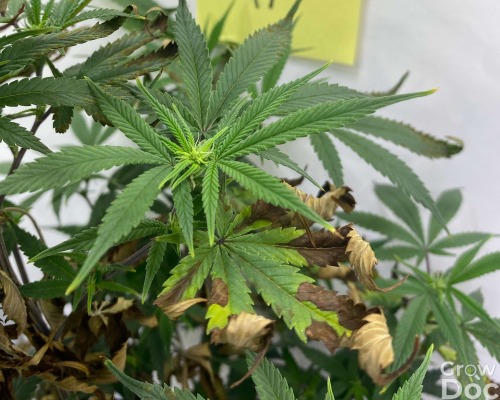
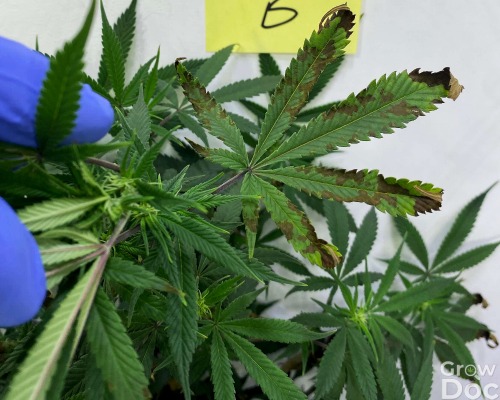
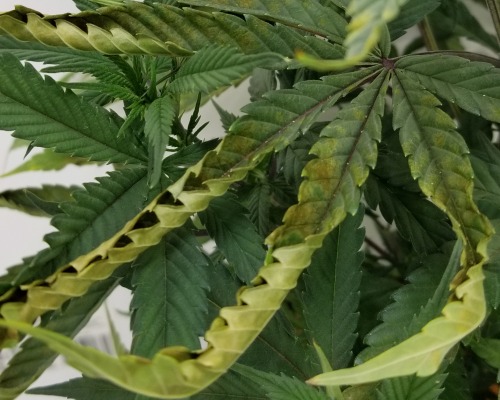
Correcting Imbalances
- For Deficiency: Introduce a phosphorus-rich supplement; bone meal is a common organic option, while various high-phosphorus bloom fertilizers are available for more immediate uptake.
- For Toxicity: Reduce phosphorus input, flush the system with pH-balanced water, and ensure a balanced nutrient solution is used to avoid further issues.
Adequate phosphorus management aligns the growth needs with the developmental stages of the cannabis plant, promoting robust root systems and bountiful blooms. Understanding how to navigate its deficiency and toxicity is vital for growers aiming for high-quality yields.
Potassium Deficiency in Cannabis Cultivation
Role of Potassium: Potassium is a regulator within the cannabis plant, responsible for various physiological processes including the activation of enzymes, the regulation of stomatal openings for gas exchange, water uptake, and overall drought tolerance. It plays a pivotal role in the synthesis of proteins and starches, nutrient transport, and the strengthening of cell walls which can affect the plant’s structural integrity and resistance to disease.
Toxicity Symptoms
- Nutrient Lockout: Excess potassium can interfere with the uptake of magnesium and calcium, leading to deficiencies in these nutrients.
- Salt Stress: High levels of potassium can cause salt stress, which may present as overall wilting or a burnt appearance similar to nutrient burn.
Deficiency Symptoms
- Chlorosis: Yellowing of leaf margins on older leaves that may progress inward with time.
- Scorched Edges: Leaf edges may appear burnt or dried out, which can be confused with light burn.
- Curling: Leaves might curl or cup upwards in response to a lack of potassium.
- Weak Stems and Slow Growth: Plants may have frail stems and display stunted growth due to compromised cell strength.
- Poor Resilience: A deficiency can lead to reduced resistance to pests and diseases.
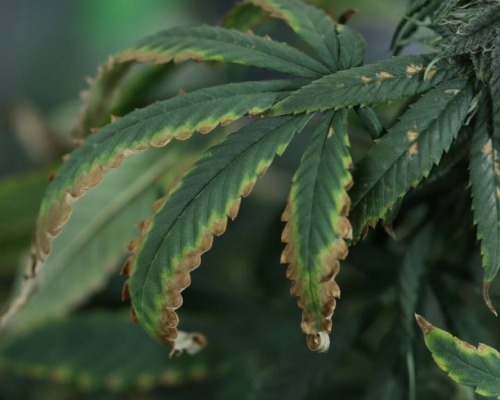
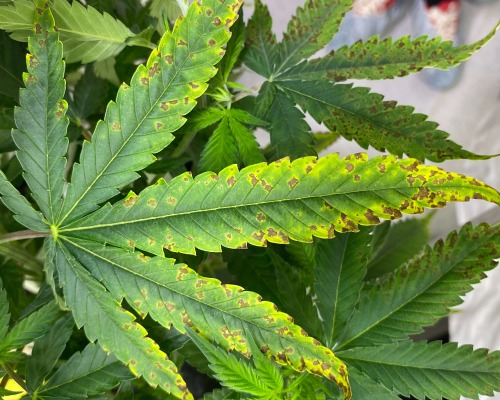
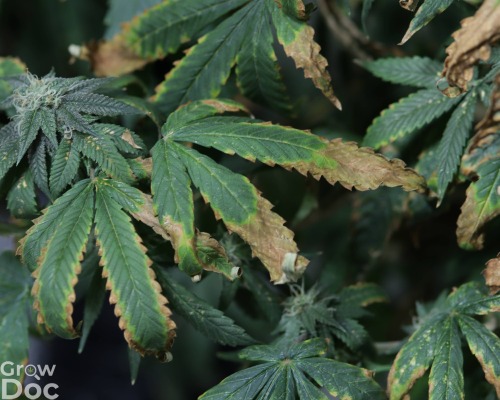
Correcting Imbalances
- For Deficiency: Supplement with a potassium-rich fertilizer; soluble potash is a common choice for a quick remedy.
- For Toxicity: Flush the soil or growing medium with pH-balanced water to leach out excess potassium and then continue with a more balanced nutrient solution.
Potassium is essential for the quality and health of the cannabis plant, influencing everything from flavor and aroma profiles to bud density and plant vigor. Proper management of potassium not only supports the plant's immediate needs but also its long-term health and productivity.
Calcium Deficiency in Cannabis Cultivation
Role of Calcium: Calcium plays a pivotal role in cannabis plant health, primarily in the development and strength of cell walls, which is crucial for the structural integrity of the plant. It's also involved in enzyme activation and signaling processes within the plant, aiding in nutrient transport and stress response regulation.
Toxicity Symptoms
- Reduced Uptake of Other Nutrients: High levels of calcium can interfere with the uptake of magnesium and potassium.
- Alkaline Soil Conditions: Excess calcium can increase soil pH, leading to a nutrient lockout of other essential elements.
Deficiency Symptoms
- Curling of Young Leaves: New growth may display curling or deformation.
- Necrotic Spots: Small, localized necrotic spots on leaves, particularly new growth.
- Stunted Growth: Calcium is vital for cell division, and its deficiency can lead to overall stunted growth.
- Weak Stems and Root Systems: Plants may exhibit frail stems and underdeveloped roots.
- Blossom End Rot in Buds: Similar to the condition seen in tomatoes, this can manifest in cannabis during flowering.
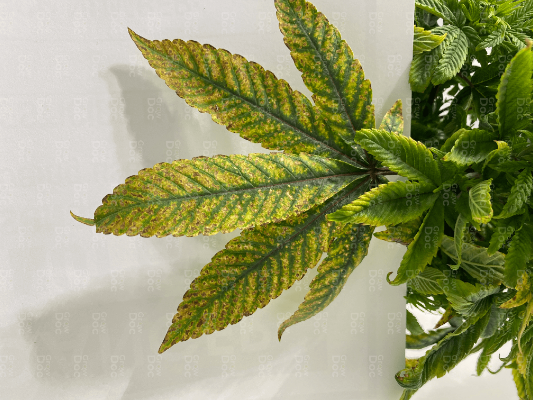
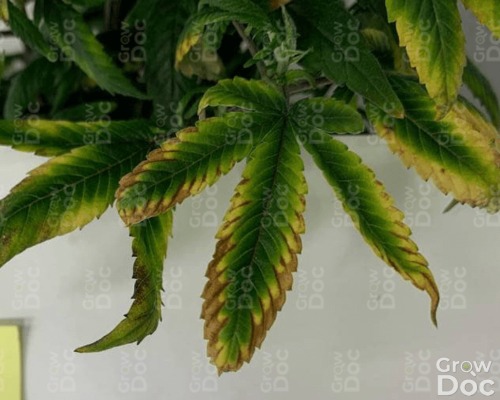
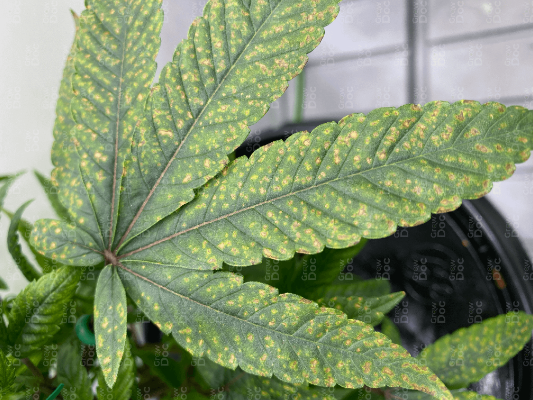
Correcting Imbalances
- For Deficiency: Apply a calcium supplement, such as calcium nitrate or a cal-mag solution, particularly if your water source is soft or low in calcium.
- For Toxicity: Reduce calcium application and consider flushing the soil with pH-balanced water. Adjust your fertilization strategy to prevent recurrence.
Calcium is less discussed than primary nutrients like NPK but is just as critical for maintaining the health and structural integrity of cannabis plants. Proper calcium management is key to ensuring robust plant growth and high-quality yields.
Magnesium Deficiency in Cannabis Cultivation
Role of Magnesium: Magnesium is a central component of chlorophyll, the molecule responsible for photosynthesis, making it crucial for the plant's energy production. It plays a vital role in enzyme activation, plant metabolism, and the synthesis of DNA and RNA. Magnesium also facilitates the movement of phosphorus within the plant and is involved in the creation of other vital compounds like ATP (adenosine triphosphate).
Toxicity Symptoms
- Nutrient Imbalance: Excessive magnesium can hinder the uptake of calcium and potassium.
- Leaf Discoloration: Leaves may turn dark green and later develop a scorched or burnt appearance.
Deficiency Symptoms
- Interveinal Chlorosis: The most common symptom, where leaves turn yellow between the veins, starting with the lower, older leaves.
- Leaf Curling and Drooping: Affected leaves may curl upwards and droop.
- Rust Spots: Older leaves may develop rust-colored spots or patches.
- Reduced Bud Production: In flowering, a magnesium deficiency can lead to smaller and fewer buds.
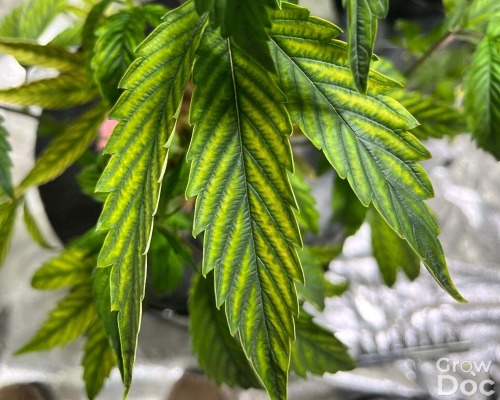
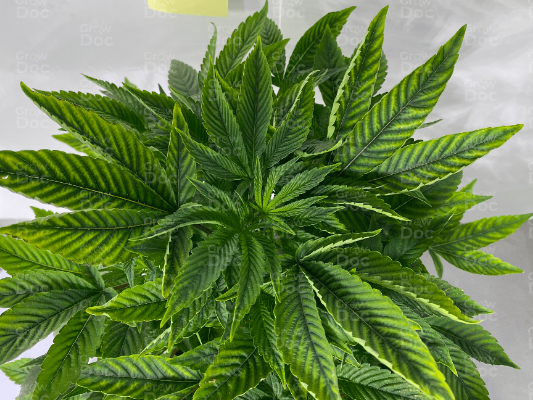
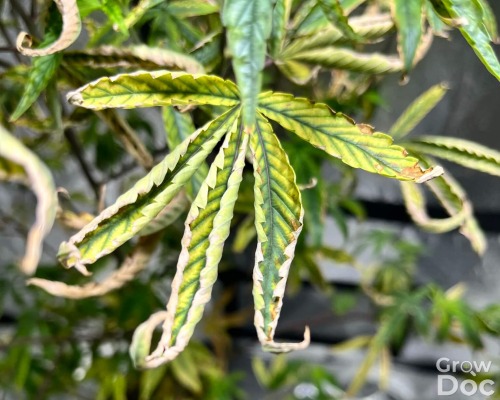
Correcting Imbalances
- For Deficiency: Supplement with a magnesium-rich fertilizer like Epsom salt (magnesium sulfate), which can be applied either to the soil or as a foliar spray.
- For Toxicity: Reduce magnesium application and flush the growing medium with pH-balanced water. Adjust fertilization practices to prevent excess accumulation.
Managing magnesium levels is essential for maintaining healthy photosynthesis and overall plant vitality. Understanding its role and how to address imbalances is key to preventing issues that can impact the health and yield of your cannabis plants.
Sulfur Deficiency in Cannabis Cultivation
Role of Sulfur: Sulfur is an often overlooked but essential nutrient in cannabis cultivation. It plays a crucial role in the synthesis of amino acids, proteins, enzymes, and vitamins, all of which are vital for plant growth and development. Sulfur is also important for the production of terpenes and cannabinoids, contributing to the aroma, flavor, and potency of the cannabis plant.
Toxicity Symptoms
- Leaf Burn: Overaccumulation can lead to a burning effect on the leaf tips, similar to nitrogen toxicity.
- Overall Plant Weakness: Excess sulfur can disrupt the nutrient balance, leading to weakened plant health.
Deficiency Symptoms
- Yellowing of Young Leaves: Unlike most other nutrient deficiencies, sulfur deficiency first appears on the newer, upper leaves.
- Stunted Growth: Plants may exhibit slowed growth rates due to reduced chlorophyll production.
- Brittle Leaves and Stems: Leaves may become brittle, and stems can be thin due to impaired protein synthesis.
- Reduced Aroma and Potency: Lower levels of terpenes and cannabinoids can result in a less aromatic and potent harvest.
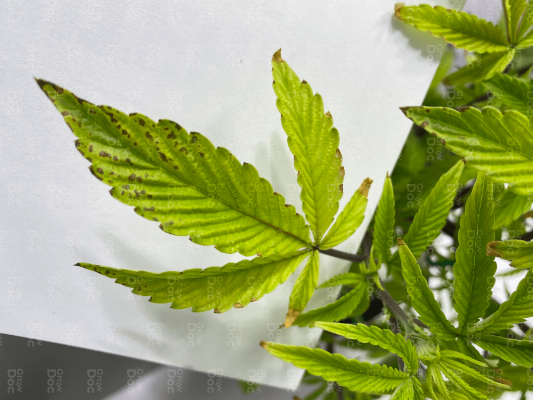

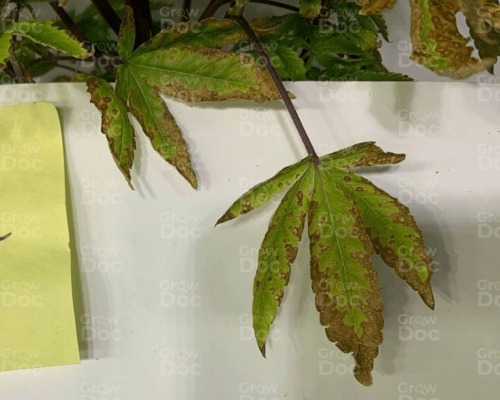
Correcting Imbalances
- For Deficiency: Introduce a sulfur supplement, such as Epsom salt (magnesium sulfate) which also provides magnesium, or a fertilizer containing sulfur.
- For Toxicity: Reduce sulfur application and consider flushing the soil with pH-balanced water to remove excess sulfur.
Sulfur is critical for maintaining the overall health, vigor, and quality of cannabis plants. Proper management of sulfur levels ensures that plants have the necessary components for strong growth and the development of desirable traits like aroma and flavor.
Boron Deficiency in Cannabis Cultivation
Role of Boron: Boron is critical in cannabis cultivation, affecting cell wall strength and reproductive processes. It ensures cell stability, influencing plant structure and yield. Adequate boron is essential for growth and reproduction, highlighting its importance in nutrient management.
Toxicity Symptoms
- Leaf Burn: Boron overaccumulation can lead to a burning effect on leaf tips.
- Overall Plant Weakness: Excessive boron disrupts nutrient balance, weakening plant health.
Deficiency Symptoms
- Stunted Growth: Boron deficiency can lead to stunted plant growth and malformed structures.
- Reproductive Issues: Insufficient boron affects pollen viability and seed production, impacting yield quality and quantity.
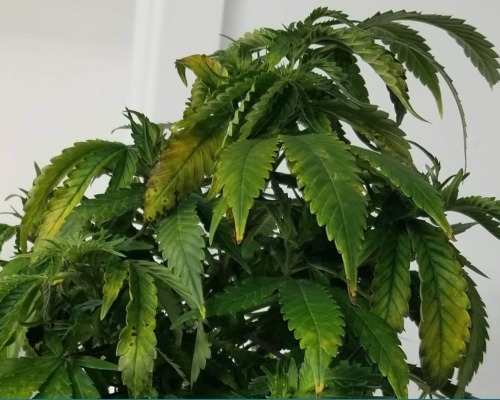
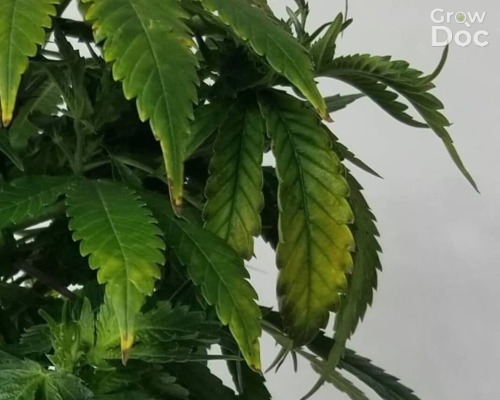
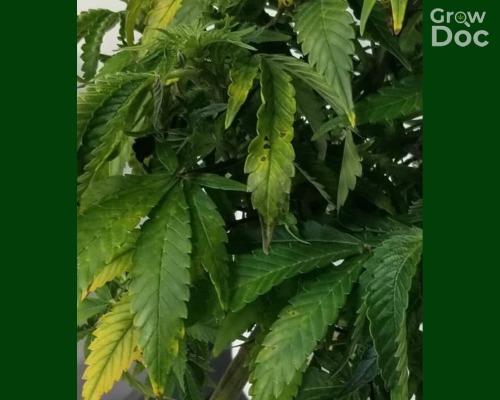
Correcting Imbalances
- For Deficiency: Apply a foliar spray containing soluble boron for quick correction or integrate a boron supplement into your nutrient regimen for ongoing management. Start with minimal doses to avoid toxicity.
- For Toxicity: Cease boron supplementation and flush your growing medium with pH-balanced water. After flushing, carefully reintroduce a balanced nutrient mix without additional boron.
Boron is essential for healthy cannabis plant development, impacting everything from structural integrity to reproductive success. Correctly managing boron levels is crucial for avoiding deficiencies and toxicities, ensuring optimal plant health and yield.
Iron Deficiency in Cannabis Cultivation
Role of Iron: Iron is pivotal for chlorophyll synthesis and crucial in the photosynthesis process, affecting energy production and plant metabolism. It plays a vital role in enzyme activities that drive plant growth, nutrient uptake, and respiratory processes. Iron's availability directly impacts the health and productivity of cannabis plants.
Toxicity Symptoms
- Burnt Leaf Tips: Excessive iron can cause leaf tips to appear burnt or browned.
- Darkened Foliage: Overabundance may lead to unusually dark green leaves.
Deficiency Symptoms
- Interveinal Chlorosis: New growth exhibits yellowing between veins while veins remain green.
- Stunted Growth: Insufficient iron can slow down growth and lead to smaller leaves.
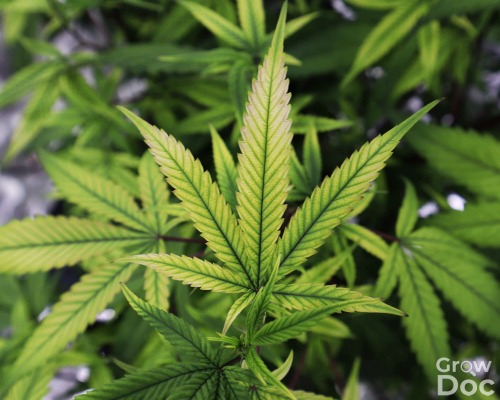

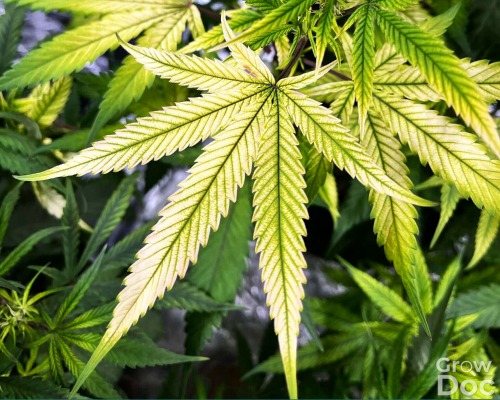
Correcting Imbalances
- For Deficiency: Address iron deficiency by applying a chelated iron supplement, ensuring it's immediately available for plant uptake. Foliar sprays can provide quick relief to affected plants.
- For Toxicity: If iron levels are too high, reduce or stop iron supplementation and flush the growing medium with pH-balanced water to dilute excess iron.
Iron is essential for the overall health and development of cannabis plants, contributing to chlorophyll production, photosynthesis, and many enzyme-driven processes. Proper management of iron levels is crucial to prevent deficiencies and toxicities, supporting optimal plant growth and productivity.
Manganese Deficiency in Cannabis Cultivation
Role of Manganese: Manganese is essential for chlorophyll production, photosynthesis, and the metabolism of nitrogen. It activates various enzymes involved in plant growth processes, contributes to the resistance against pathogens, and plays a role in the energy transfer within the plant, affecting overall health and productivity.
Toxicity Symptoms
- Brown Spots on Leaves: Excess manganese can cause dark brown spots or crinkled edges on older leaves.
- Reduced Growth: High levels of manganese can inhibit growth and lead to iron deficiency.
Deficiency Symptoms
- Interveinal Chlorosis: Younger leaves may show yellowing between the veins while the veins remain green.
- Leaf Curling and Necrosis: Severe deficiency can lead to curled leaves with dead brown edges.
Correcting Imbalances
- For Deficiency: To correct manganese deficiency, use a manganese chelate or sulfate supplement. Soil amendments like compost can also provide manganese but ensure proper pH levels to enhance its availability.
- For Toxicity: Reduce manganese supply and flush the soil or growing medium with clean, pH-balanced water to remove excess manganese. Consider testing and adjusting your water and nutrient solution to ensure it's within the optimal pH range for cannabis, which is typically between 5.5 and 6.5 for hydroponics and 6.0 to 7.0 for soil. This helps in preventing further nutrient imbalances and facilitates the absorption of essential nutrients. Additionally, incorporating a balanced nutrient regimen that accounts for all essential elements can prevent future occurrences of toxicity.
| Nitrogen (N) | Phosphorus (P) | Potassium (K) | Calcium (Ca) | Magnesium (Mg) | Sulphur (S) | Iron (Fe) | Boron (B) | Manganese (Mn) | |
|---|---|---|---|---|---|---|---|---|---|
| Leaf Chlorosis | Bottom to top yellowing on older leaves | Uniformly yellow | Yellowing leaf edges on older leaves | Mild yellowing in newer leaves | Yellowing between leaf veins | Yellowing on young growth resembling light burn | Interveinal chlorosis on young leaves | Youngest leaves become thick and brittle, terminal buds may die | Interveinal chlorosis on young leaves, grayish specks |
| Leaf Drop | Older leaves drop | — | — | — | — | — | — | Stunted growth, hollow stems in severe cases | — |
| Leaf Deformation | Leaf Cupping | — | Twisted Leaves | Cupping | — | — | — | — | Leaves may become limp |
| Leaf Necrosis | — | Dead spots | Brown leaf edges on older leaves | Brown spots | Brown spots | — | Dry, brown edges on new leaves | Death of growing points | Necrotic spots and crinkled leaves |
| Purple Discoloration | Appears on leaves and stems | Red or purple stems | — | — | — | Reddish hue on the underside of the leaves | — | — | — |
| Growth Suppression | Plant is dormant | Plant is dormant with small colas | Decreased growth | Stunted growth, potential rotting | Stunted growth | Stunted growth and loss of aroma | Severe stunting of new growth | Stunted growth, terminal bud death | Stunted or distorted growth, smaller leaf size |
| Structural Anomalies | — | — | Weak stems & branches | Weak stems, leaves & plant posture | — | The stems develop a wood-like feel | — | Brittleness in stems and petioles | Short internodes and small, distorted leaves |
| Root Distress | — | Underdeveloped root system | — | Underdeveloped root system | — | — | — | Impaired root development | Reduced root growth |
| Prevalence | Common | Common | Common | Common | Common | Uncommon | Common | Uncommon | Common |
| Nitrogen (N) | Phosphorus (P) | Potassium (K) | Calcium (Ca) | Magnesium (Mg) | Sulphur (S) | Iron (Fe) | Boron (B) | Manganese (Mn) | |
|---|---|---|---|---|---|---|---|---|---|
| Leaf Darkening | Dark green leaves | — | — | — | — | — | Dark green leaves | — | Dark green leaves |
| Leaf Tip Burn | Burnt tips | Burnt tips often with a dark edge | Burnt tips accompanied by yellow edges | Burnt tips | — | Burnt tips and brittle texture | Burnt leaf edges | Burnt tips, necrotic spots | Dark spots, burnt tips |
| Reduced Growth | Stunted growth | — | — | — | — | — | Stunted growth | Severely stunted growth | Stunted growth |
| Leaf Curling | Downward curling | Downward curling | Downward curling | — | Upwards curling | — | — | Leaf curling and twisting | — |
| Root Damage | — | — | — | Root tips may die off | — | — | — | Root browning or damage | — |
| Prevalence | Common | Common | Common | Uncommon | Uncommon | Rare | Common | Uncommon | Common |
Color Key:
Yellow - Some concern
Orange - Mild concern
Red - Severe concern
Products Recommendations for Nutrient Management
Nutrient-Specific Fertilizers
- Addressing specific nutrient deficiencies requires targeted solutions. For nitrogen deficiencies, options like blood meal or fish emulsion are effective. Phosphorus deficiencies can be managed with bone meal or rock phosphate, while potassium sulfate is ideal for addressing potassium shortages. These specialized fertilizers are crucial for precise nutrient management, ensuring that plants receive exactly what they lack without upsetting the overall nutrient balance.
Balanced Fertilizers
- A well-rounded nutritional approach is key to plant health. Future Harvest's Holland Secret Grow, Micro, and Bloom are formulated to provide a balanced blend of nitrogen, phosphorus, and potassium. These products are tailored to support cannabis plants at different growth stages - from the vegetative state through flowering - ensuring they receive the right nutrients at the right time.
Cal-Mag Supplements
- Calcium and Magnesium play pivotal roles in plant health, particularly in cell wall strength and chlorophyll production. Future Harvest's Calnesium is a reliable choice for rectifying these deficiencies. For organic growers, Organical Magic offers a natural alternative, although it's less suited for hydroponic systems due to its organic components. These supplements are vital for preventing common issues like blossom end rot and interveinal chlorosis.
pH Adjusters
- The absorption of nutrients is heavily influenced by the pH level of the growing medium. Future Harvest provides a range of pH adjusters, which are essential for maintaining the pH within the optimal range of 5.8-6.3 for cannabis. These products help in either raising or lowering the pH level, ensuring nutrients remain bioavailable to the plants.
Organic Alternatives
- For those preferring organic cultivation methods, Organical Magic offers an eco-friendly solution to nutrient supplementation. While particularly effective in soil, its organic nature means it might not be the best fit for hydroponic systems, where nutrient uptake mechanisms differ.
Monitoring Tools
- Accurate measurement and monitoring are crucial for effective nutrient management. Tools like TDS (ppm) and EC meters, available at Better Than Nature, help in quantifying nutrient concentration in the medium. Regular use of these tools enables growers to adjust nutrient levels precisely, preventing both deficiencies and toxicities.
Wrapping up this nutrient management guide, remember, your cannabis cultivation journey is a blend of care, attention, and continuous learning. This guide arms you with essential insights, but each plant's needs can vary. To dive deeper into specific deficiencies or toxicities, be sure to follow the related article links provided throughout. They're your gateway to more detailed information, helping you fine-tune your approach for every plant's unique needs. Happy growing, and keep exploring to ensure the health and vitality of your cannabis garden!
Leave A Reply
Your email address will not be published. Required fields are marked *








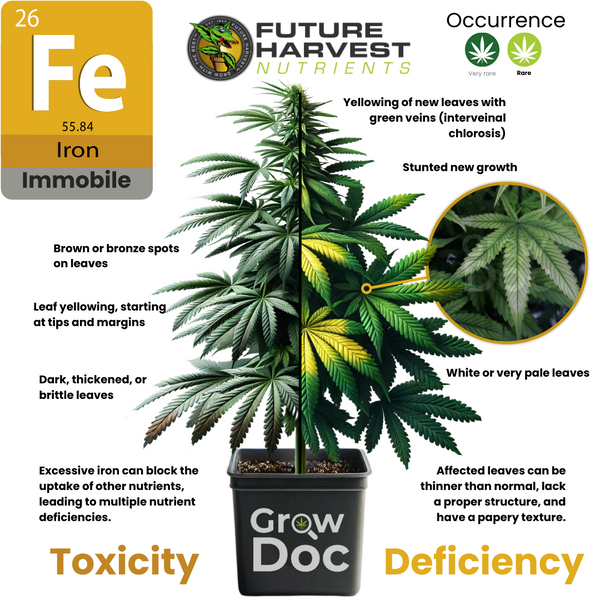
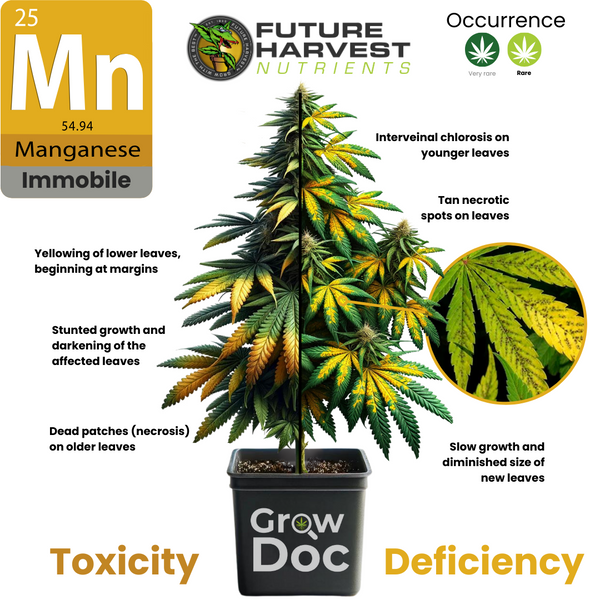
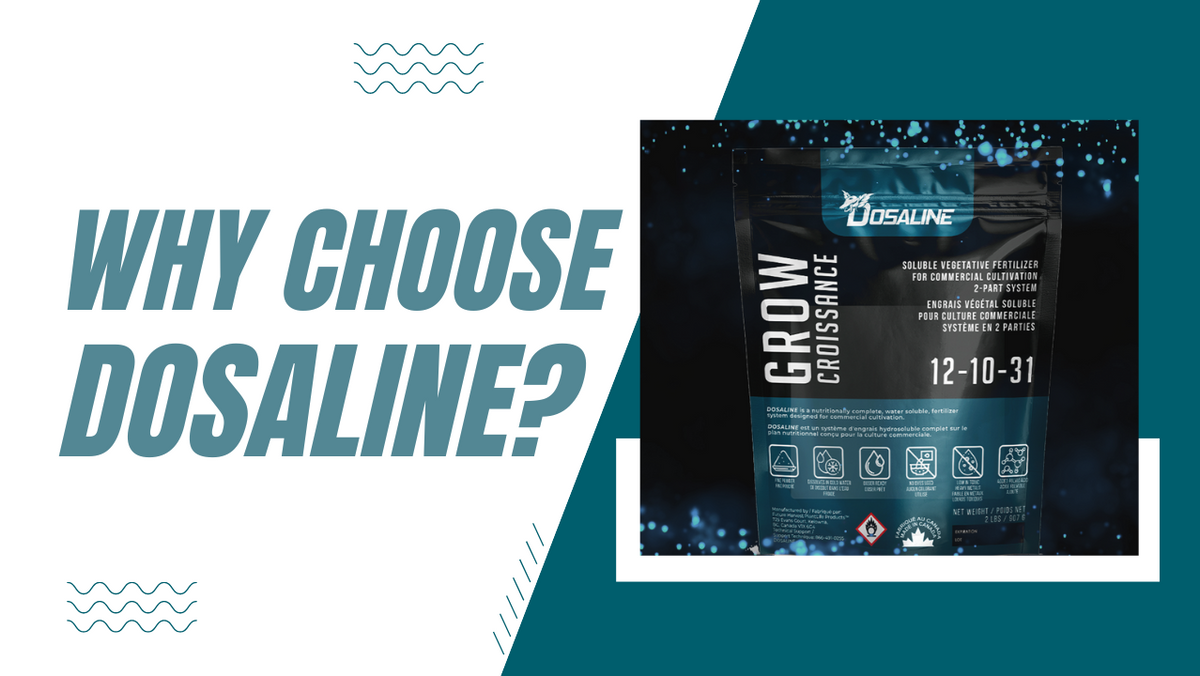


Comments
Evergreen
This article on finding and fixing nutrient deficiencies and toxicities in cannabis plants is a real game-changer! It breaks down complex topics like nutrient management and pH regulation into easy-to-understand concepts, making it accessible for growers of all levels. I love how it emphasizes the importance of balance and monitoring in plant care, comparing it to cooking a perfect recipe or managing a winning team. The distinct considerations for different grow media, whether it’s soil, hydroponics, or coco coir, show a deep understanding of the diverse needs of cannabis plants. With the insights from this article, I feel more confident in my ability to keep my plants healthy and thriving. Great job on providing such valuable and practical information!